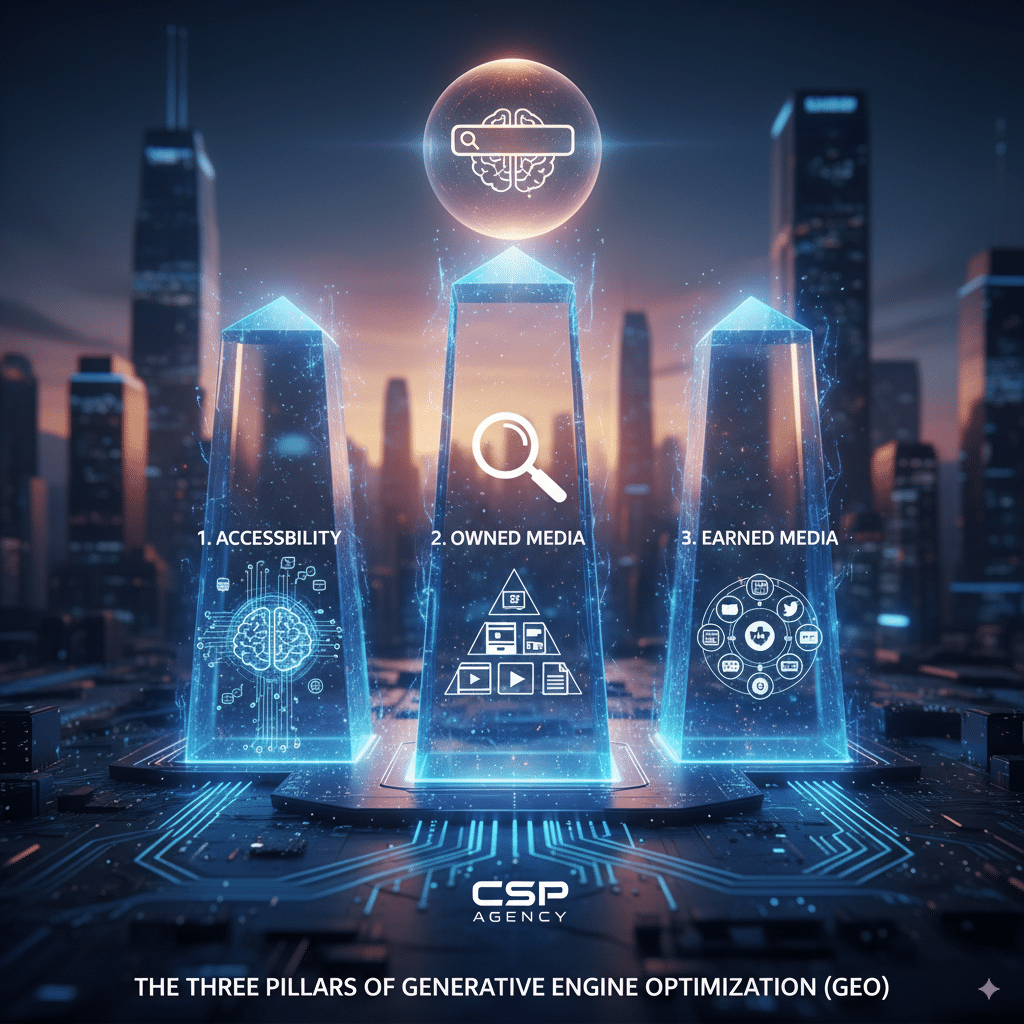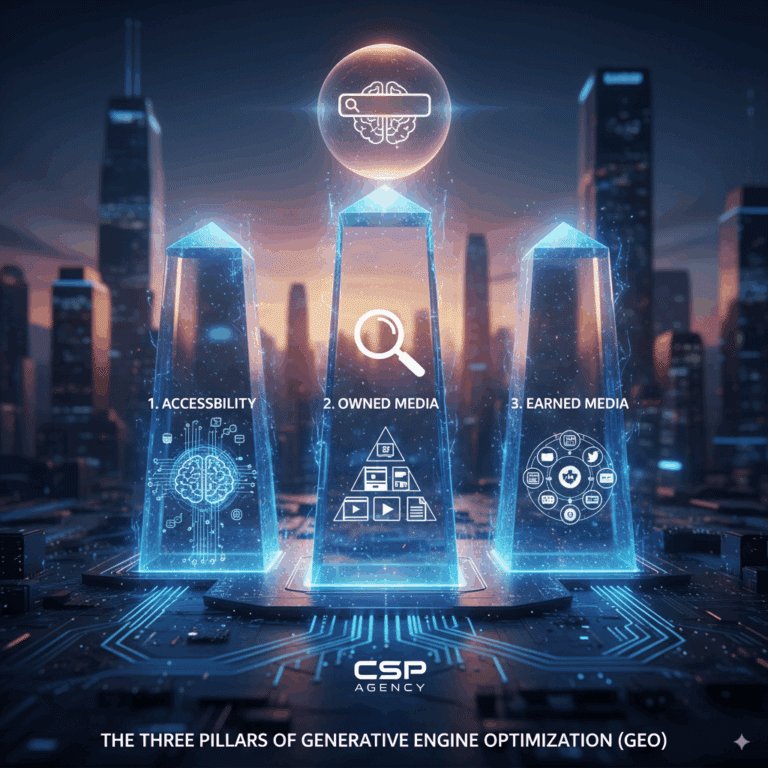The rise of generative AI has transformed how information is discovered, synthesized, and delivered. In this new search environment, traditional SEO tactics are no longer enough. Generative Engine Optimization (GEO) represents the next evolution, helping brands position themselves to be visible, credible, and influential in AI-driven results.
At CSP Agency, we have developed a framework built on three foundational pillars of GEO: Accessibility, Owned Media, and Earned Media. These pillars define how organizations should structure their digital presence to thrive in a generative search world.
Pillar 1: Accessibility
Accessibility is the technical foundation of GEO. Just as SEO requires sites to be accessible to search engine crawlers, GEO requires accessibility to AI generative engines. These engines rely on bots for crawling, as well as the indexes built by Google and Bing, which are then leveraged in retrieval-augmented generation (RAG).
Key considerations for accessibility:
- Robots.txt configuration: Ensure AI bots are not blocked. Many organizations accidentally disallow AI crawlers and cut themselves off from critical visibility.
- XML sitemaps: Properly formatted sitemaps should be submitted to both Google Search Console and Bing Webmaster Tools. This ensures AI-driven indexes receive clear signals about your content.
- IndexNow: Adoption of IndexNow helps accelerate content discovery by AI-powered engines.
- Entity schema: Structured data adds clarity around people, products, services, and organizations. While some debate remains around exactly how schema is tokenized by LLMs, the consensus is that it improves machine readability and discoverability.
- AI bot monitoring: Just as SEOs track crawl rates and indexing, brands must begin monitoring access by AI bots such as GPTBot and AnthropicBot. Understanding which bots are crawling your site provides an early indicator of how content might be included in generative outputs.
Accessibility is the prerequisite for all other GEO activity. Without it, even the best content will not be properly consumed or cited by generative engines.
Pillar 2: Owned Media
Owned media forms the core digital footprint that generative AI engines rely on to represent your brand. While accessibility ensures that AI engines can reach your content, owned media ensures there is enough depth and clarity for them to understand what you do and who you serve.
What counts as owned media?
- Your primary website
- Blog posts and articles
- Videos and podcasts
- Infographics, PDFs, and presentations
- Case studies and white papers
The website remains the most critical source. Not only is it the primary marketing channel for human users, but research shows that solution and product pages are disproportionately represented in bottom-of-funnel generative AI results.
This makes sense: when users ask an AI system for recommendations on vendors, products, or solutions, the AI often relies on explicit solution-based content. For example, “What are the best enterprise payment platforms?” will often return results anchored in solution or product pages, not top-level blogs.
Best practices for owned media in GEO:
- Build bottom-of-funnel depth: Clearly articulate your solutions, who they are for, and the problems they solve.
- Create middle-funnel resources: Case studies, comparison guides, and explainer content help AI engines connect the dots between problems and solutions.
- Use explicit language: Generative AI relies heavily on explicit mapping of problems to solutions. Content that is vague, overly branded, or lacking clarity will struggle.
- Consistency across formats: Ensure messaging is aligned across web pages, videos, and supporting assets. AI engines evaluate the consistency of signals across multiple content types.
Owned media is where brands have the most control, and it is the layer that ultimately anchors how AI understands your expertise.
Pillar 3: Earned Media
If owned media is the anchor, earned media is the amplifier. Generative AI engines look beyond your website to validate authority and relevance. This external footprint helps engines determine whether your brand deserves to be included in synthesized answers.
Forms of earned media that influence GEO:
- Industry-specific directories and databases
- Comparison articles and product roundups
- Media coverage on niche publications
- Analyst reports and thought leadership mentions
- Guest articles, interviews, and podcast appearances
In SEO, backlinks are often treated as the most valuable outcome of earned media. In GEO, the emphasis shifts from the link to the content itself. AI systems value what is being said about your brand and how consistently it aligns with your owned media.
Best practices for earned media in GEO:
- Align narratives with owned media: Ensure external mentions reinforce the same problems, solutions, and proof points found on your website.
- Seek authoritative placements: Coverage in trusted industry outlets carries disproportionate weight.
- Prioritize clarity over backlinks: While links still provide benefit, the actual context of your mention is more influential for AI-driven results.
- Track external citations: Just as link tracking is critical in SEO, monitoring third-party coverage in GEO will help you understand where AI may be sourcing its context.
Earned media extends your influence into the broader ecosystem. The stronger and more consistent this footprint, the more likely your brand is to be surfaced by AI in response to key prompts.
Our Perspective at CSP Agency
The digital landscape is evolving toward an agentic web, where optimization will increasingly shift toward AI-first strategies. However, we believe the most effective approach today is still Human-First. Content should first serve real people by being clear, helpful, and trustworthy. From there, we configure accessibility and structure so that AI engines can also consume and present it.
While spam tactics and short-term workarounds may deliver quick visibility, history has shown that these approaches rarely last. The winners in GEO will be the brands that focus on clarity, credibility, and consistency across all three pillars: accessibility, owned media, and earned media.
The Bottom Line
Generative search is not a passing trend. It is fundamentally reshaping the way information is found and trusted. Brands that take proactive steps today will be positioned not only for visibility, but also for influence in the answers AI systems deliver to millions of users.
The organizations that win in GEO will be those that:
- Ensure AI engines can access their content.
- Build robust owned media structures that communicate solutions clearly.
- Strengthen their external footprint through meaningful earned media.
The companies that wait will risk being absent from the conversation entirely.

